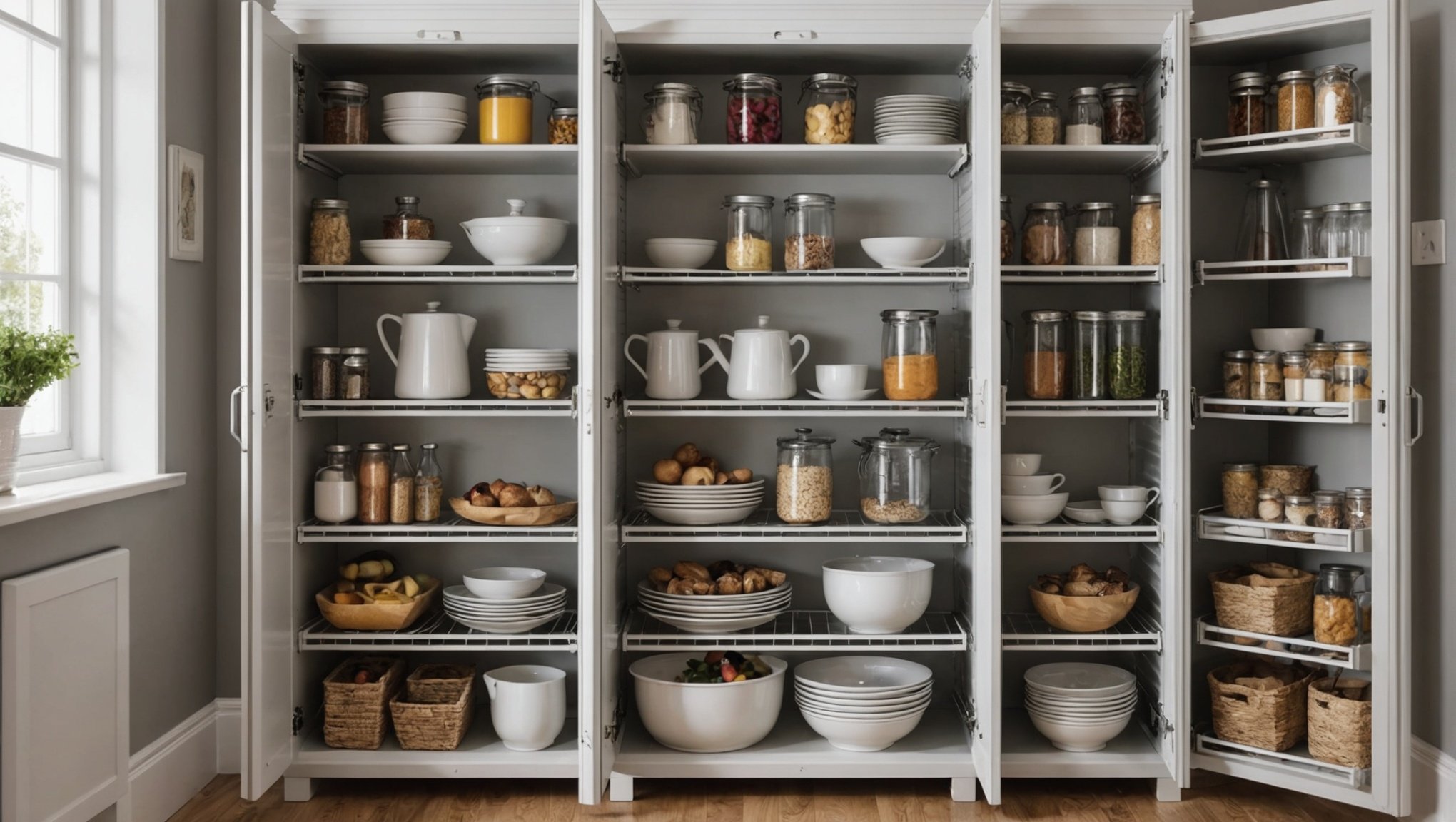Top Humidity Management Strategies for Kitchen Pantries in the UK: Effective Solutions You Need to Know
Managing humidity in your kitchen pantry is crucial for maintaining the quality and freshness of your food, preventing the growth of damp and mould, and ensuring a healthy and safe home environment. Here’s a comprehensive guide to help you understand and implement the best humidity management strategies for your kitchen pantry.
Understanding Humidity and Its Impact
Before diving into the solutions, it’s essential to understand why humidity management is vital in your kitchen pantry.
Have you seen this : Top Quiet Appliances Perfect for Open-Plan Kitchens in the UK
What is Humidity?
Humidity refers to the amount of moisture in the air. In a kitchen pantry, high humidity levels can lead to the growth of mould and damp, which can damage your food, kitchen cabinets, and even the building itself.
The Risks of Excess Moisture
Excess moisture can cause significant damage to your pantry and its contents. Here are some of the risks associated with high humidity levels:
In the same genre : Top Quiet Appliances Perfect for Open-Plan Kitchens in the UK
- Food Spoilage: High humidity can cause fruits and vegetables to spoil faster. For instance, vegetables prefer high humidity, but if it’s too high, it can lead to rot and mould growth.
- Mould and Damp: Mould thrives in moist environments and can grow on walls, ceilings, and even on food. It not only damages the structure of your home but also poses serious health risks, especially for people with respiratory conditions.
- Water Damage: Excess moisture can seep into the walls and floors, leading to water damage and structural issues in the long term.
- Energy Efficiency: High humidity levels can also affect the energy efficiency of your home. For example, if your pantry is too humid, your refrigerator and freezer may have to work harder to maintain the right temperature, increasing your energy bills.
Effective Humidity Management Strategies
Here are some effective strategies to manage humidity in your kitchen pantry:
Use of Dehumidifiers
Dehumidifiers are one of the most straightforward solutions to reduce humidity levels in your pantry. Here’s how to choose and use them effectively:
- Selecting the Right Dehumidifier: Look for a dehumidifier that is energy efficient and suitable for the size of your pantry. For example, the Meaco dehumidifier is highly recommended for its efficiency in reducing humidity levels quickly and its smart humidity mode that maintains a healthy humidity level.
- Placement and Maintenance: Place the dehumidifier in an area where it can effectively capture moisture. Make sure to empty the water tank regularly and clean the filter to ensure optimal performance.
Proper Ventilation
Good ventilation is key to managing humidity levels in your pantry.
- Extractor Fans: Installing an extractor fan in your pantry can help remove moisture from the air. Ensure that the fan is powerful enough to handle the size of your pantry and is used regularly, especially after cooking or cleaning.
- Opening Windows: Regularly opening windows, even if just for a few minutes, can help circulate air and reduce humidity levels. This is particularly effective when combined with the use of an extractor fan.
Humidity-Controlled Storage
Using storage solutions that control humidity can help maintain the right environment for your food.
- Humidity-Controlled Drawers: If you have a refrigerator with humidity-controlled drawers, use them to store fruits and vegetables. Vegetables prefer high humidity, while most fruits prefer low humidity.
- Root Cellars: For those with the space, a root cellar can be an excellent way to store produce. These cellars are designed to control humidity, temperature, ventilation, and drainage, making them ideal for long-term storage.
Practical Tips for Humidity Management
Here are some practical tips to help you manage humidity in your kitchen pantry:
Air Circulation
- Use Fans: In addition to extractor fans, using regular fans can help circulate air and reduce humidity levels.
- Avoid Clutter: Keep your pantry well-organized and clutter-free to ensure good air circulation.
Absorbing Moisture
- Baking Soda: Place baking soda in your pantry to absorb excess moisture. Replace it every few months to ensure it remains effective.
- Silica Gel: Silica gel packets can also be used to absorb moisture and maintain a dry environment.
Kitchen Design
- Well-Ventilated Kitchen Design: When designing or renovating your kitchen, ensure that it includes good ventilation systems. This can include larger windows, better airflow, and the strategic placement of extractor fans.
- Damp-Proofing: Make sure your kitchen and pantry are damp-proofed to prevent rising damp and moisture from seeping into the walls and floors.
Table: Comparing Humidity Management Solutions
| Solution | Benefits | Drawbacks |
|---|---|---|
| Dehumidifiers | Effective in reducing humidity levels quickly, energy-efficient models available | Requires regular maintenance, can be noisy, and may increase energy bills if not energy-efficient |
| Extractor Fans | Easy to install, cost-effective, and energy-efficient | May not be as effective in large spaces, requires regular cleaning |
| Humidity-Controlled Drawers | Ideal for storing fruits and vegetables, maintains optimal humidity levels | Limited to refrigerators with this feature, may require more energy |
| Root Cellars | Excellent for long-term storage, controls humidity, temperature, and ventilation | Requires significant space and initial investment |
| Baking Soda and Silica Gel | Inexpensive, easy to use, and effective in absorbing moisture | Needs to be replaced regularly, may not be as effective in high-humidity environments |
Real-Life Examples and Anecdotes
A Personal Experience with Dehumidifiers
“I recently moved into a new home and noticed that my kitchen pantry was always damp. After some research, I decided to use a dehumidifier. The Meaco dehumidifier I chose was a game-changer. It reduced the humidity levels significantly within a few hours, and the smart humidity mode ensured that the levels remained stable. Now, my pantry is dry and free from mould, and I can store my food without worrying about spoilage,” says Sarah, a homeowner in London.
The Importance of Ventilation
“During my kitchen renovation, I made sure to include a powerful extractor fan. It has made a huge difference in maintaining a dry and well-ventilated pantry. I open the windows regularly, especially after cooking, and the extractor fan helps to remove any excess moisture. This combination has prevented any damp or mould from forming,” explains John, a DIY enthusiast.
Managing humidity in your kitchen pantry is not just about preventing damp and mould; it’s also about maintaining the freshness and quality of your food, ensuring energy efficiency, and creating a healthy home environment. By using dehumidifiers, ensuring proper ventilation, utilizing humidity-controlled storage solutions, and following practical tips, you can effectively manage humidity levels in your pantry.
Final Tips
- Regular Maintenance: Make sure to regularly check and maintain your humidity management solutions to ensure they are working effectively.
- Monitor Humidity Levels: Use a hygrometer to monitor humidity levels in your pantry and adjust your strategies accordingly.
- Combine Solutions: Using a combination of dehumidifiers, extractor fans, and humidity-absorbing materials can provide the best results.
By implementing these strategies, you can create a pantry that is not only free from damp and mould but also a place where your food stays fresh and healthy for a longer period. Remember, effective humidity management is key to a well-maintained and efficient kitchen.






